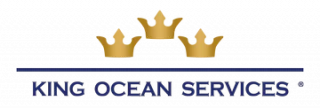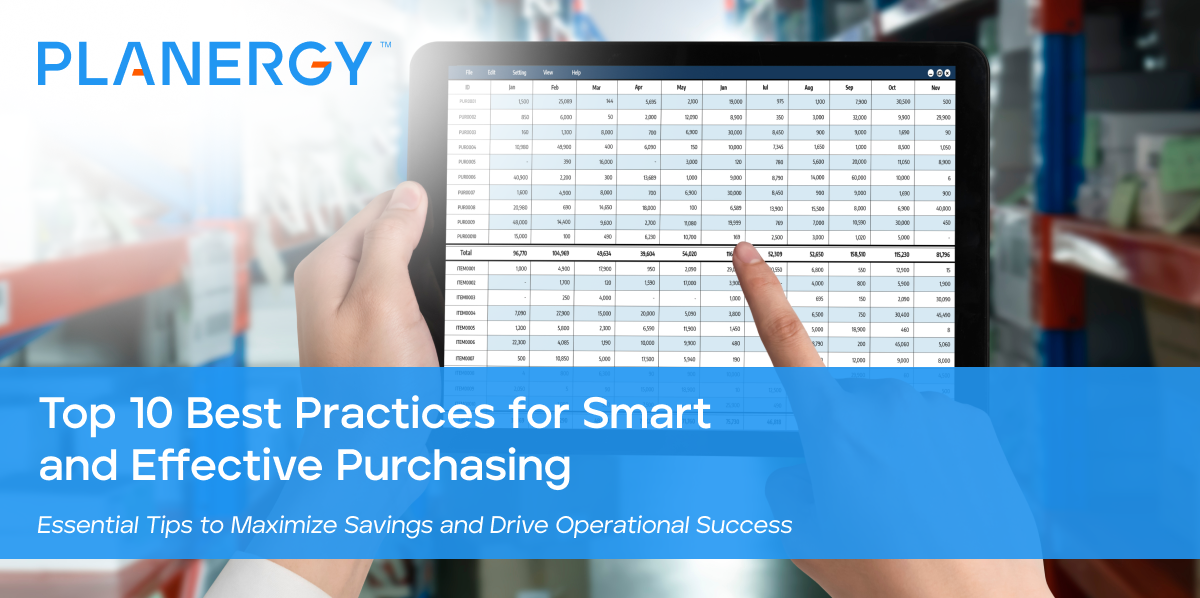Procurement is critical for maintaining competitive pricing and high-quality standards while ensuring smooth operations.
For procurement managers, the challenge lies in juggling various tasks, such as managing vendor relationships, automating purchasing, and minimizing risks.
Here, we’ll explore best practices that can help streamline procurement processes and address common challenges faced by professionals in this domain.
Benefits of Implementing Procurement Best Practices
Organizations that adopt procurement best practices can unlock numerous advantages, contributing to their overall efficiency and success.
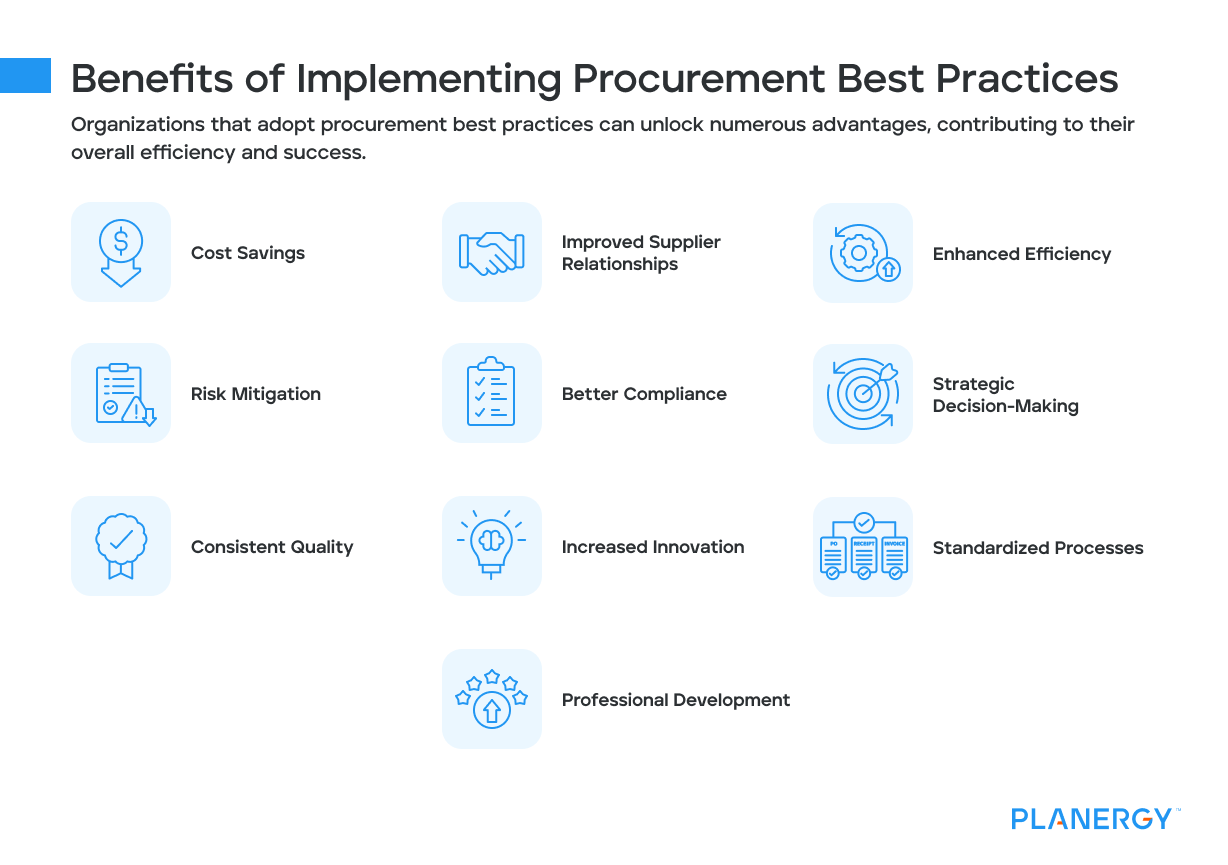
Cost Savings
Implementing best practices in procurement helps organizations achieve significant cost reductions through strategic sourcing, competitive bidding, and effective negotiation.
Efficient procurement processes minimize waste and optimize resource utilization.
Improved Supplier Relationships
Regular communication, performance reviews, and mutual trust foster strong vendor relationships.
These relationships lead to better pricing, priority service, and access to innovative products, ensuring a reliable supply chain.
Enhanced Efficiency
Automation of procurement processes reduces manual errors and speeds up the procure-to-pay cycle.
Streamlined workflows and integrated systems free up resources, allowing teams to focus on strategic activities rather than administrative tasks.
Risk Mitigation
A proactive approach to risk management identifies potential vulnerabilities in the supply chain early on.
Organizations can mitigate risks such as supply disruptions, quality issues, and compliance breaches by developing contingency plans and continuously monitoring supplier performance.
Better Compliance
Maintaining transparency and adhering to regulatory requirements is crucial for avoiding legal issues and maintaining a positive reputation.
Best practices ensure clear documentation, accountability, and adherence to ethical sourcing standards.
Strategic Decision-Making
Access to accurate data and market insights enables informed decision-making.
Organizations can adapt to market changes, negotiate better contracts, and select suppliers offering long-term value rather than immediate cost savings.
Consistent Quality
Establishing and maintaining clear quality standards ensures that suppliers meet expected performance levels.
Regular audits and reviews help maintain high-quality outputs, reducing the incidence of defects and returns.
Increased Innovation
Encouraging a culture of continuous improvement and openness to new technologies within the procurement team drives innovation.
This leads to more efficient processes, cost savings, and better supplier engagements.
Standardized Processes
Clear procurement policies and standardized processes ensure consistency and efficiency across the organization.
This reduces the likelihood of errors and ensures all stakeholders are aligned with organizational objectives.
Professional Development
Investing in the professional development of the procurement team enhances their skills and expertise.
A knowledgeable team is better equipped to execute effective procurement strategies and contribute to the organization’s success.
10 Procurement Best Practices to Follow
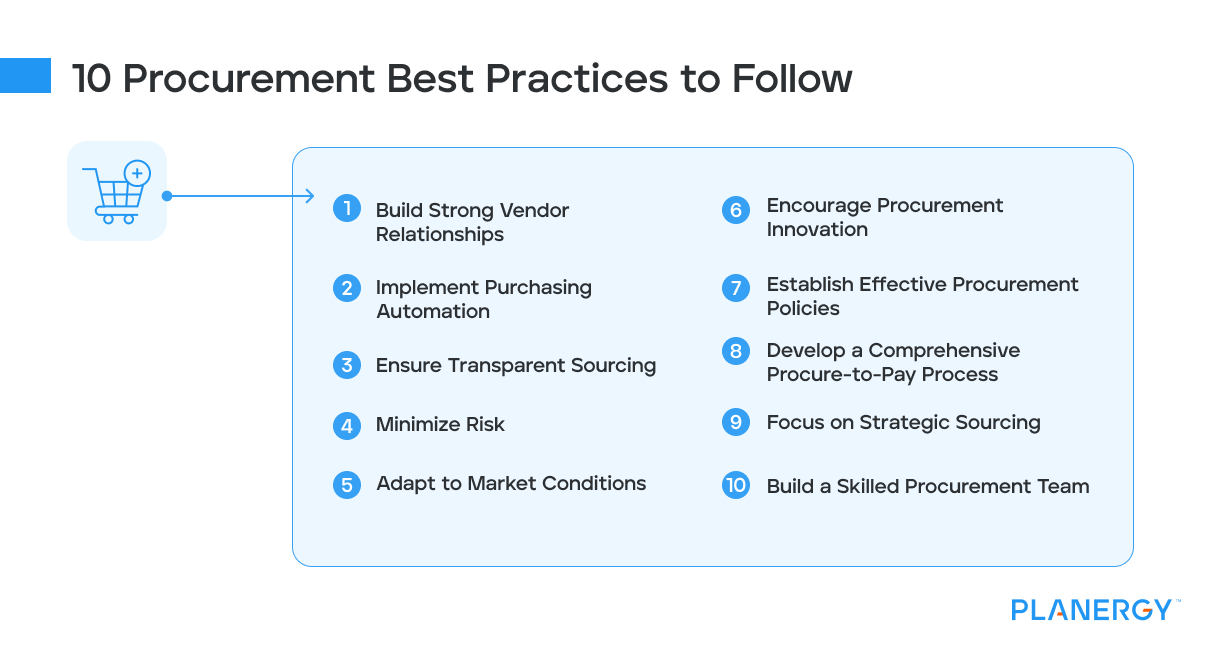
Build Strong Vendor Relationships
A successful procurement strategy starts with cultivating strong relationships with your vendors.
This involves regular communication, understanding vendor capabilities, and negotiating favorable terms.
A solid relationship can lead to better pricing, priority treatment during shortages, and access to innovative products or services.
Schedule regular meetings with key suppliers to discuss performance metrics, expectations, and any upcoming changes in demand.
Use collaborative tools and platforms to maintain clear and consistent communication.
Implement Purchasing Automation
One of the most significant advances in procurement is the automation of purchasing processes.
By leveraging technology, businesses can reduce manual data entry errors, speed up procurement cycles, and free up resources for strategic activities.
Use procurement software that integrates seamlessly with your existing systems to automate order processing, invoice management, and payment approvals.
An e-procurement platform, for example, can help manage purchase orders and approvals seamlessly.
Ensure Transparent Sourcing
Transparency in sourcing is essential for maintaining ethical standards and building trust with stakeholders.
Clear documentation and reporting practices ensure accountability and compliance with regulatory requirements.
Maintain a centralized database of all sourcing activities, contracts, and supplier information to make transparency and auditing a breeze.
Minimize Risk
Risk management is vital in procurement to protect your organization from potential supply chain disruptions, quality issues, and non-compliance penalties.
Identifying and mitigating risks requires a proactive approach and robust risk assessment tools.
Develop a risk management framework that includes vendor evaluations, contingency planning, and regular reviews of risk exposure.
Adapt to Market Conditions
The market is constantly changing, and procurement managers must adapt quickly to fluctuations in pricing, demand, and supply chain dynamics.
Staying informed about market trends can help them make informed decisions and adjust strategies accordingly.
Collaborate with industry peers, attend trade shows, and use market intelligence tools to stay ahead of trends.
Encourage Procurement Innovation
Encouraging innovation within the procurement team can lead to more efficient processes, cost savings, and better supplier engagements.
This involves fostering a culture of continuous improvement and openness to new technologies.
Provide training and development opportunities for your team to learn about the latest procurement innovations and best practices.
Establish Effective Procurement Policies
Clear procurement policies help standardize processes and ensure consistency across the organization.
These policies should be well-documented and communicated to all stakeholders to avoid misunderstandings or non-compliance.
Review and update procurement policies regularly to reflect current business needs and regulatory requirements.
Develop a Comprehensive Procure-to-Pay Process
A streamlined procure-to-pay process is essential for efficient procurement operations.
This involves integrating requisition, purchase order, receipt, and payment processes to optimize the end-to-end cycle.
Use e-procurement solutions to integrate and automate each step of the procure-to-pay cycle.
Focus on Strategic Sourcing
Strategic sourcing involves evaluating and selecting suppliers based on their ability to deliver long-term value rather than just immediate cost savings.
This approach ensures high-quality goods and services and aligns with organizational goals.
Create a balanced scorecard for evaluating suppliers based on quality, reliability, innovation, and cost-effectiveness criteria.
Build a Skilled Procurement Team
Having a skilled and knowledgeable procurement team is crucial for executing effective procurement strategies.
Invest in their professional development to ensure they have the necessary skills and expertise.
Continuous training and development ensure team members stay updated with industry best practices and new technologies.
Offer regular training sessions and workshops on procurement best practices, new tools, and industry trends.
Encourage your procurement professionals to pursue certifications like Certified Professional in Supply Management (CPSM) or Certified Supply Chain Professional (CSCP).
Overcoming Common Challenges
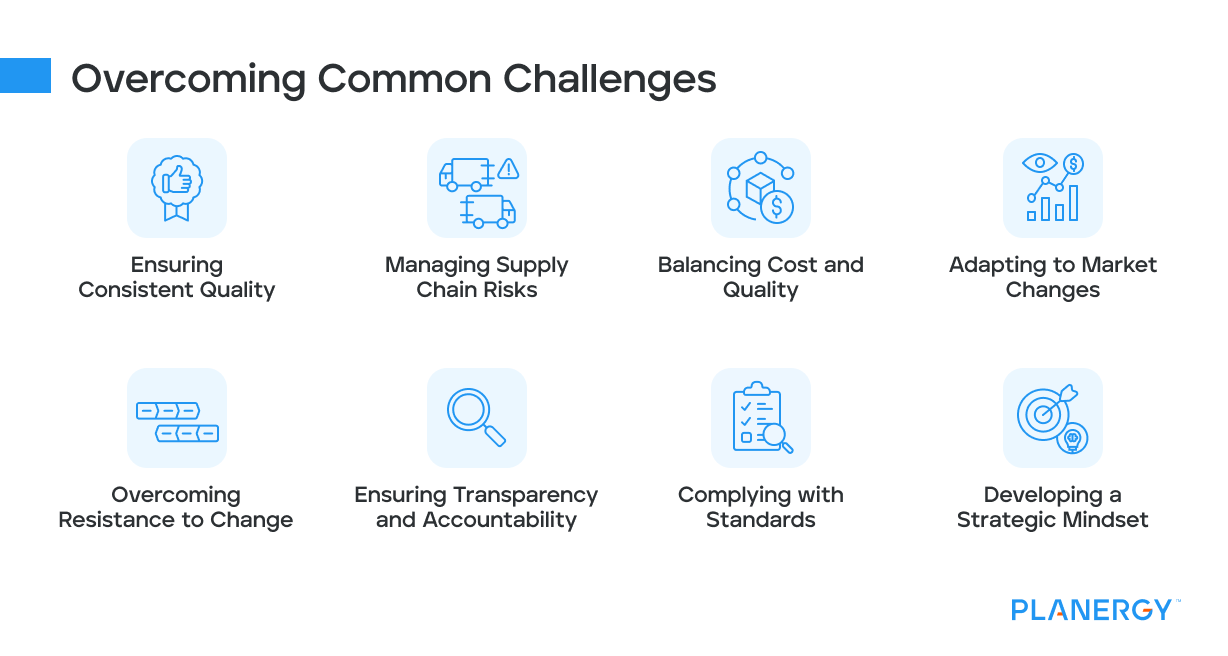
Ensuring Consistent Quality
Establish clear quality standards and criteria for suppliers to maintain consistent quality.
Regular audits and performance reviews can help ensure compliance and identify areas for improvement.
Managing Supply Chain Risks
Develop comprehensive contingency plans to address potential supply chain disruptions.
This may include diversifying suppliers, increasing inventory levels (as opposed to relying on just-in-time inventory management), or identifying alternative materials.
Balancing Cost and Quality
Striking a balance between cost savings and quality requires a strategic approach to supplier selection and contract negotiation.
Focus on the total cost of ownership rather than just upfront costs.
Adapting to Market Changes
Stay agile and responsive by closely monitoring market trends and adjusting procurement strategies.
This may involve renegotiating contracts or exploring new sourcing options.
Overcoming Resistance to Change
Address resistance to change by involving key stakeholders in decision-making processes and demonstrating the benefits of adopting new technologies or practices.
Ensuring Transparency and Accountability
Implement comprehensive reporting and documentation practices to ensure transparency and accountability throughout the procurement process.
Complying with Standards
Stay informed about regulatory requirements and ethical sourcing standards to ensure compliance and maintain a positive reputation.
Developing a Strategic Mindset
Foster a culture of strategic thinking within the procurement team by providing resources and training to enhance their ability to make informed decisions.
Common Mistakes to Avoid in Procurement
Organizations often encounter common pitfalls in optimizing procurement processes that can hinder their success.
Awareness of these mistakes and taking proactive steps to avoid them can significantly enhance efficiency and outcomes.
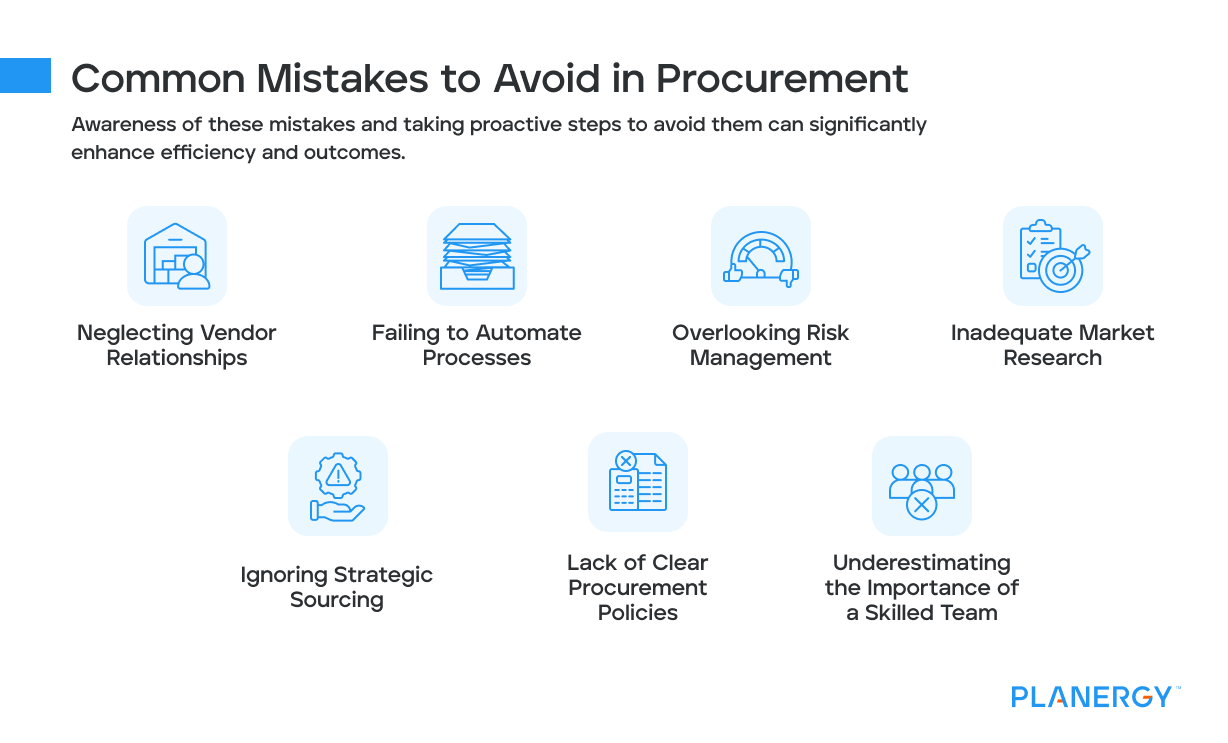
Neglecting Vendor Relationships
Strong vendor relationships are the backbone of an effective procurement strategy.
Neglecting these relationships with providers can lead to poor supplier performance, higher costs, and supply chain disruptions.
Allocate dedicated time for regular supplier relationship management.
Schedule periodic performance reviews and engage in open dialogues to understand their capabilities and promptly address concerns.
Failing to Automate Processes
Relying on manual processes like spreadsheets can result in errors, inefficiencies, and delays.
Procurement automation is key to streamlining activities and leveraging data for informed decision-making.
Invest in high-quality procurement software that integrates with your existing ERP systems.
Automate repetitive tasks that often lead to bottlenecks, such as purchase requests, purchase order processing, invoice management, and payment approvals, to free up resources for strategic initiatives.
For instance, your accounts payable team can pay invoices sooner to capitalize on early payment discounts, while your procurement leaders can spend more time nurturing relationships.
Overlooking Risk Management
Ignoring potential risks in the procurement process can expose your organization to significant vulnerabilities, including supply chain disruptions, quality issues, and compliance breaches.
Develop a comprehensive risk management framework that includes regular risk assessments, contingency planning, and continuous monitoring of vendor performance.
Engage in proactive risk mitigation strategies to safeguard your operations.
Inadequate Market Research
Failing to stay informed about market conditions and trends can result in missed opportunities and suboptimal procurement decisions.
Conduct thorough market research and leverage market intelligence tools to stay updated on pricing trends, new technologies, and emerging suppliers.
Regularly review and adjust your procurement strategy based on market insights.
Ignoring Strategic Sourcing
Focusing solely on immediate cost savings rather than long-term value can compromise the quality and reliability of goods and services.
Embrace the strategic sourcing process by evaluating suppliers’ ability to deliver long-term value.
Develop a balanced scorecard for supplier selection that considers quality, innovation, reliability, and total cost of ownership.
Lack of Clear Procurement Policies
Unclear or outdated procurement policies can lead to inconsistencies, non-compliance, and inefficiencies across the organization.
Establish well-documented procurement policies and ensure they are communicated to all stakeholders.
Regularly review and update these policies to align with current business needs and regulatory requirements.
Underestimating the Importance of a Skilled Team
A procurement team lacking the necessary skills and expertise can struggle to execute effective procurement strategies and make informed decisions.
Invest in the professional development of your purchasing team.
Encourage team members to pursue relevant certifications and provide ongoing training opportunities to enhance their capabilities.
How to Streamline Purchasing in Your Organization
Streamlining the purchasing process is essential for enhancing efficiency, reducing costs, and ensuring timely procurement of goods and services.
Standardize Procedures
Creating standardized procedures ensures consistency and clarity across the organization.
This reduces the likelihood of human error and ensures all team members follow the same steps, making the process more efficient.
Develop a comprehensive procurement manual outlining each purchasing process step.
Include templates for purchase orders, approval forms, and vendor evaluation criteria. Train your team on these standardized procedures to ensure compliance across all business processes.
Centralize Procurement Data
Centralizing procurement data enables better tracking, analysis, and decision-making.
It ensures that all relevant information is easily accessible in real-time and reduces the risk of data silos.
Use a centralized procurement system to store all purchase orders, contracts, and supplier information.
Ensure that this system is regularly updated and accessible to all relevant stakeholders.
Implement a Vendor Management System
A vendor management system (VMS) helps manage supplier relationships (for better partnerships), track performance, and ensure contract compliance.
It provides a structured approach to vendor evaluation and selection.
Choose a VMS that offers features such as vendor performance tracking, risk assessment, and contract management.
Regularly review vendor performance using key metrics and address any issues proactively.
Foster Cross-Functional Collaboration
Collaboration between different departments ensures that the purchasing process aligns with overall business objectives.
It enhances transparency and helps identify potential areas for improvement.
Establish cross-functional teams that include members from procurement, finance, operations, and other relevant departments.
Hold regular meetings to discuss procurement needs, challenges, and opportunities for optimization.
Monitor and Analyze Procurement Metrics
Regular monitoring and analysis of procurement metrics help identify inefficiencies and areas for improvement.
Key performance indicators (KPIs) provide insights into the effectiveness of your purchasing process.
Track KPIs such as order cycle time, cost savings, supplier lead times, and compliance rates.
Use these metrics to benchmark performance and implement corrective actions where necessary.
Turn to Best Practices to Make Procurement Easier
Procurement best practices are essential for achieving operational efficiency, cost savings, and long-term success.
Procurement managers can overcome common challenges and drive positive outcomes by focusing on vendor relationships, automation, transparency, and strategic sourcing.
Implement these practices to elevate your procurement processes and position your organization for growth and success.
PLANERGY can help you implement many of these into your procurement process.
It offers a centralized VMS, contract repository, and automation for your entire P2P process.
